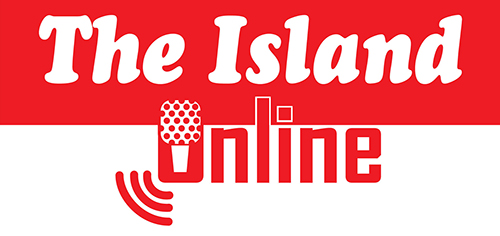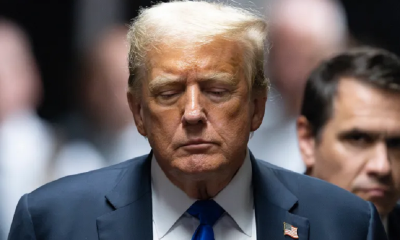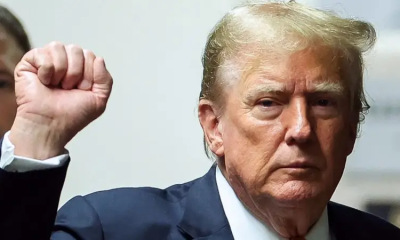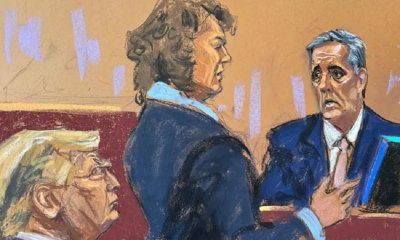Foreign News
Trump hush money trial: Michael Cohen admits to stealing
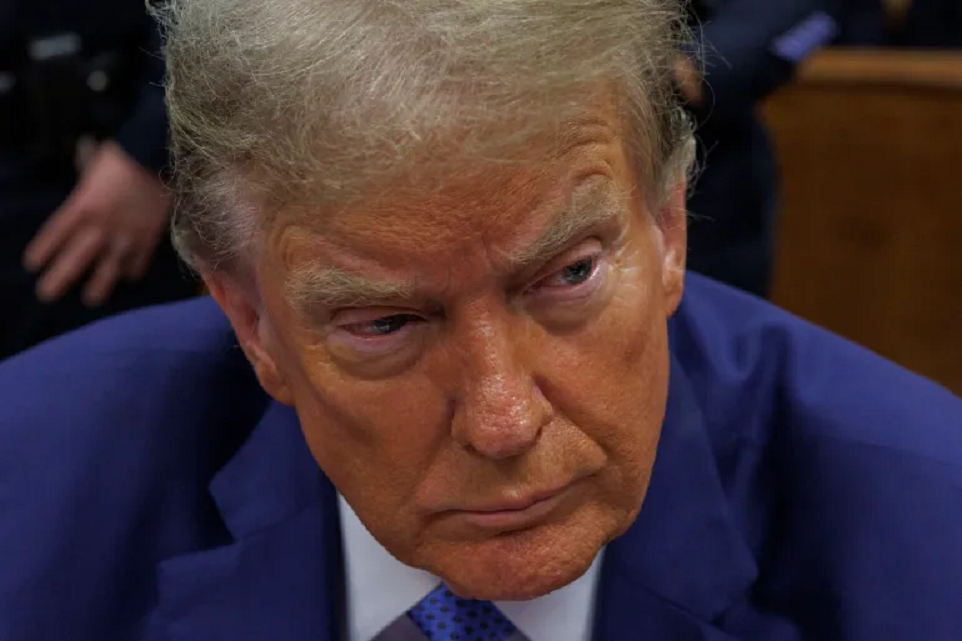
Disbarred lawyer Michael Cohen has completed his testimony before a New York criminal courtroom, as the case against his boss, former United States President Donald Trump, approaches its likely end.
Monday marked Cohen’s fourth and final day on the witness stand. His words were the last witness testimony the prosecution called before resting its case.
Now, the trial shifts towards the defence, as it seeks to rebut allegations that Trump falsified business records to conceal a hush-money payment to a former adult film actress – and thereby bolster his chances in the 2016 presidential election.
In October 2016, Cohen transferred $130,000 to the adult film actress Stormy Daniels to buy her silence about an affair she alleged she had with then-candidate Trump.
Cohen has maintained that he made the payment at Trump’s command, and that Trump then reimbursed the payment through surreptitious means, filing it under “legal expenses”.
But on Cohen’s last day on the stand, the defence sought to puncture that narrative, attacking Cohen’s credibility by drawing attention to instances where he lied and stole.
The defence has consistently maintained that Trump had nothing to do with the payment. Trump himself has denied any wrongdoing and refuted Daniels’s allegation of an affair.
Day 19 of the New York hush-money trial also marked the start of a short week. Not only is the witness list for the defence expected to be relatively brief, but the court is scheduled to break early this week, to accommodate the Memorial Day holiday in the US.
Trump faces 34 felony counts of falsifying business records in the case. Here are the takeaways from Cohen’s final day of testimony.

Former President Donald Trump told reporters outside the Manhattan Criminal Court on Monday that the prosecution has ‘no case’ (Aljazeera)
Cohen admits to stealing from Trump Organization
Before ending its cross-examination of Cohen on Monday, the defence landed a significant blow to his credibility, getting him to admit that he had stolen $30,000 from Trump’s namesake company.
Defence lawyer Todd Blanche asked Cohen outright: “You stole from the Trump Organization, right?”
Cohen offered his standard response, “Yes, sir.”
The theft came after Cohen hired the technology company Red Finch to help boost Trump’s numbers in an online poll from CNBC, ranking the best businessmen of the past half-century.
Cohen testified that Trump was “upset” that he had landed towards the bottom of the poll. By hiring Red Finch, Cohen explained that he and Trump could manipulate the poll: The tech company would cast false votes on Trump’s behalf using different IP addresses.
Red Finch was originally slated to be paid $50,000 for its services, Cohen explained. But he told the jury that he instead paid Red Finch $20,000 to “placate” its owner and then pocketed the rest, after Trump decided to reduce his holiday bonus. “I was angered because of the reduction in the bonus, and so I just felt like it was self-help,” Cohen said.
Blanche pressed the issue during his cross-examination: “Have you paid back the Trump Organization the money you stole from them?”
“No, sir,” Cohen said.
Trump’s entourage in the courtroom took the admission as a major coup for his defence.
“This just got interesting: Michael Cohen is now admitting to stealing money from our company,” Trump’s second son Eric posted on social media.
Kash Patel, an official under Trump’s administration, told reporters outside the courtroom that “we finally have a crime”. “We also have a victim,” he added. “That victim is Donald J Trump.”

Cohen reveals he made millions from media appearances
The defence has long maintained that Trump himself is not guilty of falsifying business records — but that figures like Cohen and the Trump Organization’s former chief financial officer, Allen Weisselberg, were responsible for any misdeeds.
As the defence team brought its cross-examination of Cohen to a close, it sought to paint a portrait of Cohen’s alleged greed, highlighting the ways he profited from his association with Trump.
Cohen testified that, after Trump was elected president in 2016, he made about $4m from consulting contracts, including with AT&T, a telecommunications company seeking a merger at the time.
In 2018, however, Cohen pleaded guilty to campaign finance violations and other federal crimes, including lying to Congress. He was sentenced to prison as a result.
But when he was transferred to home confinement in 2020, he took on an increasingly public role as a Trump critic. Cohen testified that, starting in 2020, he made approximately $4.4m from tell-all books and podcast appearances.
The defence also asked Cohen about a reality TV show called The Fixer he had been shopping to networks, though he said no studio has picked it up yet.

Cohen cross-examination ends, prosecution rests
In the final minutes of Cohen’s cross-examination, the defence tried to impress upon the jury that there were holes in the former lawyer’s testimony. While Cohen has maintained that the hush-money payments were falsely logged as “legal expenses”, the defence has maintained the label is accurate, as Cohen was in fact Trump’s personal lawyer.
The defence also questioned whether Cohen could accurately recollect his conversations with Trump from October 2016, the month when the hush-money payment was made.
“Notwithstanding everything you’ve said over the years, you have specific recollection of having conversations with then-candidate Donald J Trump about the Stormy Daniels matter?” Blanche, the defence lawyer, asked.
Cohen answered his usual “yes, sir”.
“No doubt in your mind?” Blanche asked again. “No doubt,” Cohen responded.
The cross-examination ended shortly thereafter, and the prosecution briefly stood to question Cohen one last time.
Prosecutor Susan Hoffinger took the opportunity to point out that Trump’s actions were on trial, not Cohen’s. “I know you might feel like you’re on trial here after cross-examination, but are you actually on trial here?” she asked Cohen.
“No, ma’am,” he replied.
The prosecution also asked Cohen to reflect upon what speaking out against Trump has cost him.
“My entire life has been turned upside down as a direct result,” Cohen responded, citing a decline in his family’s wellbeing as well as his professional prospects. “I lost my law license, my businesses, my financial security, which I was fortunately enough early to have been able to obtain.”
With that, the prosecution rested its case.

Defence calls its first witnesses, including feisty Costello
With the prosecution’s case at an end, it was time for the defence to take its turn to call witnesses.
The first was a paralegal named Daniel Sitko, who works for Blanche, the defence lawyer.
Sitko presented a chart that gave an overview of the phone calls between Cohen and Robert Costello, a lawyer who previously offered to transmit messages between Cohen and Trump.
The defence only questioned Sitko long enough to establish that Cohen’s communications with Costello were frequent, particularly in 2018 when he faced legal troubles.
Then, the defence’s second witness took the stand: Costello himself.
The decision to call Costello was not without controversy. The prosecution objected to his inclusion: Cohen has admitted to lying to Costello, and for his part, Costello has taken a prominent public role in questioning Cohen’s credibility.
Costello was also a late addition to the defence’s list of possible witnesses, and Judge Juan Merchan was forced to rule quickly about how much of Costello’s testimony he would allow.
Merchan said Costello could “offer some rebuttal” to Cohen’s testimony, but the judge added he would not allow the situation to become a “trial within a trial”.
But right away, Costello’s appearance on the witness stand was tense: The lawyer audibly reacted when the prosecution raised objections to his testimony, saying “jeez” and calling the situation “ridiculous”.
It was enough to earn a stern rebuke from Judge Merchan, who briefly cleared the courtroom to address Costello directly.
“Mr Costello, I want to discuss proper decorum in my courtroom. When there’s a witness on the stand, if you don’t like my ruling, you don’t say ‘jeez’,” Merchan said. “You don’t give me side eye, and you don’t roll your eyes.”
Costello was ultimately allowed to resume his testimony, which centred on allegations that Cohen lied about Trump’s knowledge of the hush-money payments.
“Michael Cohen said numerous times that President Trump knew nothing about those payments, that he did this on his own, and he repeated that numerous times,” Costello said.

Trump’s court entourage includes Hells Angels
The day ended with Costello’s fiery appearance on the witness stand and the prospect of further questioning from prosecutors on Tuesday.
While much of the court’s attention was focused on the final witnesses in the trial, members of Trump’s entourage also caught the media’s eye.
Seated among Trump’s inner circle was Chuck Zito, the former president of the New York chapter of the Hells Angels bikers club.
Now an actor, Zito faced his own criminal charges and served a prison sentence from 1985 to 1991.
Also in the audience were Congress members like Representative Andrew Clyde of Georgia. “What needs to happen is this particular judicial-type system needs to be defunded,” Clyde said, calling for federal funding to be cut to Manhattan’s courts.
Trump himself spoke to the press outside of the courtroom, revisiting familiar themes that the prosecution was politically motivated, and complaining about the “freezing cold” setting.
“They have no case. They have no crime,” Trump said, adding that the judge was “corrupt” and “interfering with an election”.
Trump is expected to face President Joe Biden, a Democrat, in November’s presidential race.
(Aljazeera)
Foreign News
Nasa ‘Earthrise’ astronaut dies at 90 in plane crash

Apollo 8 astronaut Bill Anders, who snapped one of the most famous photographs taken in outer space, has died at the age of 90.
Officials say a small plane he was flying crashed into the water north of Seattle, Washington.
Anders’ son Greg confirmed that his father was flying the small plane, and that his body was recovered on Friday afternoon. “The family is devastated. He was a great pilot. He will be missed,” a statement from the family reads.
Anders – who was a lunar module pilot on the Apollo 8 mission – took the iconic Earthrise photograph, one of the most memorable and inspirational images of Earth from space.
Taken on Christmas Eve during the 1968 mission, the first crewed space flight to leave Earth and reach the Moon, the picture shows the planet rising above the horizon from the barren lunar surface.
Anders later described it as his most significant contribution to the space programme.
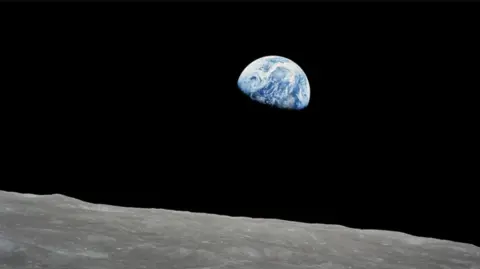
The image is widely credited with motivating the global environmental movement and leading to the creation of Earth Day, an annual event to promote activism and awareness of caring for the planet.
Speaking of the moment, Anders said: “We came all this way to explore the Moon, and the most important thing that we discovered was the Earth.”
Officials said on Friday that Anders crashed his plane around 11:40PDT (1940BST).
The US National Transportation Safety Board (NTSB) said the 90-year-old was flying a Beechcraft A A 45 – also known as a T-34. The agency said that the plane crashed about 80ft (25m) from the coast of Jones Island.
Anders also served as the backup pilot to the Apollo 11 mission, the name of the effort that led to the first Moon landing on July 24, 1969.
Following Anders’ retirement from the space programme in 1969, the former astronaut largely worked in the aerospace industry for several decades. He also served as US Ambassador to Norway for a year in the 1970s.
But he is best remembered for the Apollo 8 mission and the iconic photograph he took from space.
“In 1968, during Apollo 8, Bill Anders offered to humanity among the deepest of gifts an astronaut can give. He traveled to the threshold of the Moon and helped all of us see something else: ourselves,” Nasa Administrator Bill Nelson said in a statement.
Mark Kelly, a former astronaut who now serves as a US Senator for the state of Arizona, said in a post on X, formerly Twitter, that Anders “inspired me and generations of astronauts and explorers. My thoughts are with his family and friends”.
[BBC]
Foreign News
China’s Chang’e-6 lifts off from far side of Moon with rock samples

A Chinese spacecraft carrying rock and soil samples from the far side of the Moon has lifted off from the lunar surface to start its journey back to Earth, according to state media.
The achievement on Tuesday is a world first and the latest leap for Beijing’s decades-old space programme, which aims to send a crewed mission to the Moon by 2030.
The Xinhua News Agency, citing the China National Space Administration (CNSA), said that the ascender of the Chang’e-6 probe took off at 7:38am local time on Tuesday (23:38 GMT) and entered a preset orbit around the moon.
It described the move as “an unprecedented feat in human lunar exploration history”.
The Chang’e-6 probe was launched last month and its lander touched down on the far side of the Moon on Sunday. It used a drill and robotic arm to dig up soil on and below the Moon’s surface, according to Xinhua.
After successfully gathering its samples, the Chang’e-6 unfurled China’s national flag for the first time on the far side of the Moon, it said.
The agency cited the CNSA as saying that the spacecraft stowed the samples it had gathered in a container inside the ascender of the probe as planned.
[Aljazeera]
Foreign News
China says its spacecraft lands on Moon’s far side

China says its uncrewed craft has successfully landed on the far side of the Moon – an unexplored place almost no-one tries to go.
The Chang’e 6 touched down in the South Pole-Aitken Basin at 06:23 Beijing time on Sunday morning (22:23 GMT Saturday), the China National Space Administration (CNSA) said.
Launched on 3 May, the mission aims to collect precious rock and soil from this region for the first time in history. The probe could extract some of the Moon’s oldest rocks from a huge crater on its South Pole.
The landing was fraught with risks, because it is very difficult to communicate with spacecraft once they reach the far side of the Moon. China is the only country to have achieved the feat before, landing its Chang’e-4 in 2019.
After launching from Wenchang Space Launch Center, the Chang’e 6 spacecraft had been orbiting the Moon waiting to land. The lander component of the mission then separated from the orbiter to touch down on the side of the Moon that faces permanently away from Earth.
During the descent, an autonomous visual obstacle avoidance system was used to automatically detect obstacles, with a visible light camera selecting a comparatively safe landing area based on the brightness and darkness of the lunar surface, the CNSA was quoted as saying by state-run Xinhua news agency.
The lander hovered about 100m (328ft) above the safe landing area, and used a laser 3D scanner before a slow vertical descent. The operation was supported by the Queqiao-2 relay satellite, the CNSA said.
Chinese state media described the successful landing as an “historic moment”. The state broadcaster said “applause erupted at the Beijing Aerospace Flight Control Center” when the Chang’e landing craft touched down on the Moon early on Sunday morning.
The lander should spend up to three days gathering materials from the surface in an operation the CNSA said would involve “many engineering innovations, high risks and great difficulty”. “Everyone is very excited that we might get a look at these rocks no-one has ever seen before,” explains Professor John Pernet-Fisher, who specialises in lunar geology at the University of Manchester.
He has analysed other lunar rock brought back on the American Apollo mission and previous Chinese missions. But he says the chance to analyse rock from a completely different area of the Moon could answer fundamental questions about how planets form.
Most of the rocks collected so far are volcanic, similar to what we might find in Iceland or Hawaii. But the material on the far side would have a different chemistry . “It would help us answer those really big questions, like how are planets formed, why do crusts form, what is the origin of water in the solar system?” the professor says.
The mission aims to collect about 2kg (4.4lb) of material using a drill and mechanical arm, according to the CNSA.
The South Pole–Aitken basin, an impact crater, is one of the largest known in the solar system.
From there, the probe could gather material that came from deep inside the lunar mantle – the inner core of the Moon – Prof Pernet-Fisher says.
The Moon’s South Pole is the next frontier in lunar missions – countries are keen to understand the region because there is a good chance it has ice.
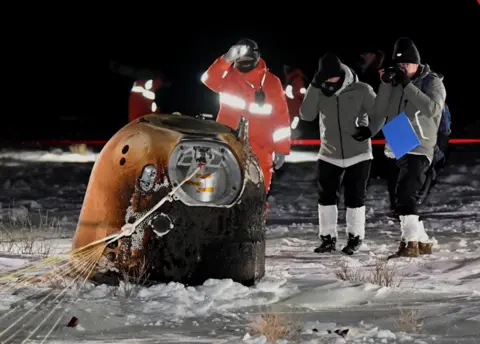
The capsule in the last Chinese moon mission, Chang’e 5, brought back soil and rocks in 2020 (BBC)
Access to water would significantly boost the chances of successfully establishing a human base on the Moon for scientific research.
If the mission succeeds, the craft will return to Earth with the precious samples on board a special return capsule.
The material will be kept in special conditions to try to keep it as pristine as possible.
Scientists in China will be given the first chance to analyse the rocks, and later researchers around the world will be able to apply for the opportunity too.
This is the second time China has launched a mission to collect samples from the Moon.
In 2020 Chang’e 5 brought back 1.7kg of material from an area called Oceanus Procellarum on the Moon’s near side.
China is planning three more uncrewed missions this decade as it looks for water on the Moon and investigates setting up a permanent base there.
Beijing’s broader strategy aims to see a Chinese astronaut walk on the moon by around 2030.
The US also aims to put astronauts back on the moon, with Nasa aiming to launch its Artemis 3 mission in 2026.
(BBC)

